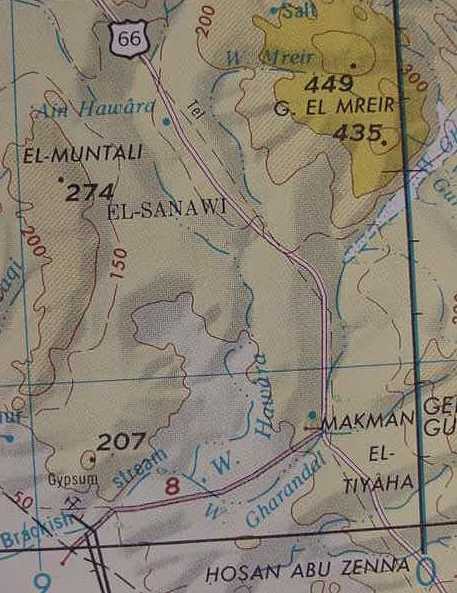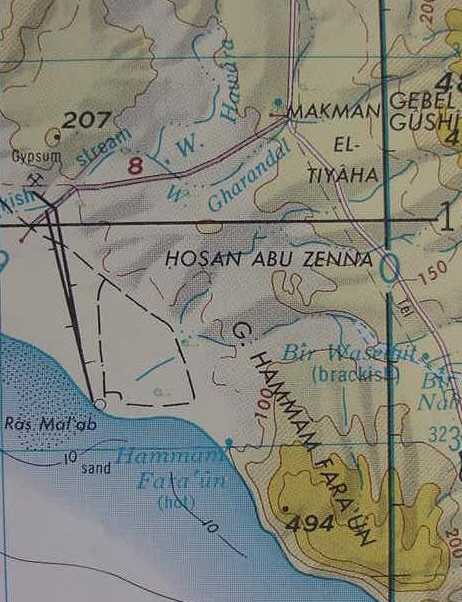The Wilderness of Sin is El Sanawi and/or Hisan Abu Zena or Abu Zenima?
20 April 2010 (Revisions through 18 July 2010)
The Exodus has the Israelites leaving Elim and its 12 springs and 70 trees for the Wilderness of Sin:
Exodus 16:1 RSV
"They set out from Elim, and all the congregation of the people of Israel came to the wilderness of Sin which is between Elim and Sinai, on the fifteeneth day of the second month after they had departed from the land of Egypt."
Having identified Elim and its 12 springs with Ayun Musa and its 12/15 springs, perhaps the wilderness of Sin is preserved in some arabic toponymn to the south of Ayun Musa? There are several contending locations whose names, for me, recall the Hebrew Sin, they are in descending order from north to south:
(1) El Sanawi:
A plain north of Wady Gharandel.
(2) Hosan abu Zenna (alternately rendered as Hisan abu Zena):
A plain south of Wady Gharandel which is marked off by two heaps of stones recording the supposed distance of a horses' leap once owned by an Arab called Abu Zena, rendered by Palmer as Mangaz Hisan Abu Zena, "Abu Zena's Horse's Leap,"(p. 47. E. H. Palmer. The Desert of the Exodus: Journeys on foot in the wilderness of the forty years' wanderings. New York. Harper & Brothers, Publishers. 1872).
(3) Ras Abu Zenima (alternately a settlement called Abu Zenima):
A headland (Ras) and settlement located at the edge of the Gulf of Suez and south of Hosan/Hisan abu Zenna/Zena. The coastal plain about Zenima may have been envisioned as the wilderness of Sin if Zenima preserves Sin?
To the degree that a place possessing water would make an appropriate camp site perhaps Wady Gharandel wedged between El Sanawi and Hisan abu Zena is where Israel camped in the wilderness of Sin? Gharandel possesses a small brook and trees. That is to say Sin may be preserved in the two plains of Sanawi and Hisan abu Zena flanking Wadi Gharandal's brook and trees. Said plains might qualify for the Hebrew term midbar meaning "wilderness"?
Numbers 33:10-11 slips another site in between Elim and the wilderness of Sin, a campsite not identified by name, it is said to lie near Yam Suph (the Red Sea). Of interest here is that one European explorer stated that upon reaching Wady Gharandel he followed it "toward the Sea" until he came to a circle of trees and a flowing brook. Could this "going towards the Red Sea" preserve the notion of Israel's camp being by or near the Red Sea in Numbers 33:10?
"And they set out from Elim, and encamped by the Red Sea, and they set out from the Red Sea, and encamped in the wilderness of Sin..." (Nu 33:10-11)
If the Red Sea encampent is toward the west-end of Wadi Gharandel then the wilderness of Sin might be preserved in the plain south of this wady called Hisan Abu Zena by Palmer?
Bartlett (1879):
"...from Ain Hawwara we entered wady Gharandel...we followed the wady toward the sea, between high banks till, in a little circle of trees and shrubs, we found our tents nearly ready..."
(p. 203. Samuel Colcord Bartlett. From Egypt to Palestine through Sinai the wilderness and South Country.
New York. Harper. 1879)
According to Numbers after leaving the wilderness of Sin Israel camped at Dophkah. Two sites suggest Dophkah for me:
(1) Wadi Dafari and its well of Qattar Dafari:
on the coastal plain south of Abu Zenima.
(2) Wadi Foka:
in the great plain east of Serabit el Khadim.
Below, maps showing the highland plains of El Sanawi and Hosan Abu Zenna possible (?) contenders for the wilderness of Sin (Suez, United Arab Republic. 1970. Scale: 1:250,000. Sheet NH 36-10. Series 1501. Washington D.C.):
Below, Ras Abu Zenima (Headland of Abu Zenima), a possible contender for the wilderness of Sin, allowing that Sin might be preserved in Zenima and the wilderness is the coastal plain (Qal'et el Nakhl, Egypt. 1972. Scale: 1:250,000. Washington D.C. Sheet NH 36-11)
Most scholars suggest the large coastal plain south of Ras Abu Zenima is the wilderness of Sin, but I have rejected this identification for two reasons:
(1) I do not find a toponym in this area resembling the word Sin.
(2) I identify Dophkah (Numbers 33:12) which follows the wilderness of Sin with Wady Dafari which is at the north end of this coastal plain.
Numbers 33:10 RSV
"And they set out from the wilderness of Sin, and encamped at Dophkah."
Apparently while within the Wilderness of Sin Israel complains about a lack of flesh to eat and God rains down upon quail from the sea (Ex 16:1-13). It is a fact that in the Spring (the time of the Exodus according to the Bible) quail do migrate north from the Great Lakes area of Africa and their flyway is over the Gulf of Suez (biblical Red Sea).
Please click here for additional information on the Sinai quail.
Israel is also fed Manna while in the Wilderness of Sin (Ex 16:14-38) and according to 19th century AD European travelers Manna is collectible from Tamarisk trees in the vicinity of Wadi Gharandal, which is flanked by two toponyms resembling Sin: El Sanawi north of the wadi and Hosan Abu Zenna south of the wadi. Please click here for more information about Manna being found in the vicinity of Wady Gharandal.
Conclusions:
The Wilderness of Sin could be either El Sanawi, Hosan abu Zenna/Zena or Ras Abu Zenima. To the degree that Israel gathers manna in this wilderness, which is associated with tamarisk trees, Wadi Gharandal's tamarisk trees were known to produce manna in various 19th century AD European travelers' accounts, and it lies between Sanawi and Hosan Abu Zenna, which might preserve in a somewhat corrupted form, Sin.


